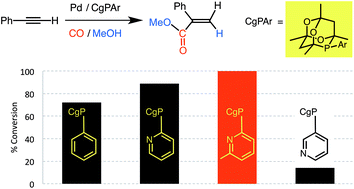2-Pyridyl substituents enhance the activity of palladium–phospha-adamantane catalysts for the methoxycarbonylation of phenylacetylene†
Abstract
The synthesis of a series of CgPAr ligands is reported, where CgP is the 6-phospha-2,4,8-trioxa-1,3,5,7-tetramethyladamant-6-yl moiety and Ar = 2-pyridyl (L2), 3-pyridyl (L3), 2-pyrimidyl (L4), 4-R-2-pyridyl [R = Me (L5a), CF3 (L6a), SiMe3 (L7a)] or 6-R-2-pyridyl [R = Me (L5b), CF3 (L6b), SiMe3 (L7b). Testing of these ligands in the Pd-catalysed methoxycarbonylation of phenylacetylene reveals that the activity and branched selectivity of the catalysts derived from these ligands varies as a function of the N-heterocycle, with the catalyst derived from L5b being the most active of those tested. This, together with the poor performance of catalysts derived from L3 supports the hypothesis that the catalysis proceeds by a “proton shuttling” mechanism, an idea that previously had only been applied to arylphosphines. Reaction of [PtCl2(cod)] with L where L = L2 or L4–7 yields a rac/meso mixture of the trans-[PtCl2(L)2] (1a–h) complexes, three of which are structurally characterised. 31P NMR spectroscopy shows that reaction of L3 with [PtCl2(cod)] gives a mixture of mononuclear and binuclear metal complexes in solution. The complex trans-[PdCl2(L2)2] (4) reacts with AgBF4 to give the [PdCl(κ1-L2)(κ2-L2)]BF4 (5) with spectroscopic and structural characterisation confirming the presence of a P,N-chelate. 1H and 31P NMR evidence supports the assignment of a pyridyl-protonated species being formed upon treatment of 4 with TsOH·H2O in CD2Cl2; both the protonated species and chelate 5 are observed when the reaction is carried out in MeOH.


 Please wait while we load your content...
Please wait while we load your content...